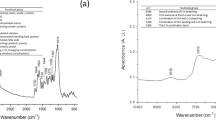Abstract
The effectiveness of ozonization and adsorption on nanodiamonds in decreasing the content of aflatoxin B1 is investigated in this paper. The successive treatment of aflatoxin B1 by water-soluted ozone and modified nanodiamond hydrosol is shown to result in the higher neutralization of the toxin than employing these methods separately. This makes it possible for us to suggest a new approach to detoxication. This approach involves the volume ozonization of goods infected by aflatoxin B1, followed by the use of nanodiamond hydrosol to adsorb the residual toxin.
Similar content being viewed by others
References
A. P. Puzyr’, I. O. Pozdnyakova, and V. S. Bondar’, “Design of a Luminescent Biochip with Nanodia-monds and Bacterial Luciferase,” Fiz. Tverd. Tela (St. Petersburg) 46 (4), 740–742 (2004) [Phys. Solid State 46 (4), 761–763 (2004)].
A. P. Puzyr’, A. V. Baron, K. V. Purtov, E. V. Bortnikov, N. N. Skobelev, O. A. Mogilnaya, and V. S. Bondar’,“Nanodiamonds with Novel Properties: A Biological Study,” Diamond Relat. Mater. 16, 2124–2128 (2007).
V. S. Bondar’, I. O. Pozdnyakova, and A. P. Puzyr’, “Applications of Nanodiamonds for Separation and Purification of Proteins,” Fiz. Tverd. Tela (St. Petersburg) 46(4), 737–739 (2004) [Phys. Solid State 46 (4), 758–760 (2004)].
A. M. Schrand, H. Huang, C. Carlson, J. J. Schlager, E. Øsawa, S. M. Hussain, and L. Dai, “Are Diamond Nanoparticles Cytotoxic?” J. Phys. Chem. B 111, 2–7 (2007).
A. Krueger, “New Carbon Materials: Biological Applications of Functionalized Nanodiamond Materials,” Chem.—Eur. J. 14, 1382–1390 (2008).
A. P. Puzyr’, V. S. Bondar’, Z. Yu. Selimkhanova, E. V. Inzhevatkin, and E. V. Bortnikov, “Results of Investigating the Possible Application of Detonation-Synthesis Nanodiamonds as an Enterosorbent,” Sib. Med. Obozr. 2–3(31–32), 25–28 (2004).
A. P. Puzyr’, K. V. Purtov, O. A. Shenderova, M. Luo, D. W. Brenner, and V. S. Bondar’, “The Adsorption of Aflatoxin B1 by Detonation-Synthesis Nanodiamonds,” Dokl. Akad. Nauk 417(1), 117–120 (2007) [Dokl. Biochem. Biophys. 417 (1), 299–301 (2007)].
N. Gibson, O. Shenderova, T. J. M. Luo, S. Moseenkov, V. Bondar, A. Puzyr, K. Purtov, Z. Fitzgerald, and D. W. Brenner, “Colloidal Stability of Modified Nanodiamond Particles,” Diamond Relat. Mater. 18(4), 620–626 (2009).
International Union Against Cancer; http://www. uicc.org.
J. L. Richard, G. A. Payne, A. E. Desjardin, C. Mara-gos, W. P. Norred, J. J. Pestka, T. D. Phillips, H. P. van Egmond, P. J. Vardon, T. B. Whitaker, and G. Wood, “Mycotoxins: Risks in Plant, Animal, and Human Systems,” in Task Force Report (Council for Agricultural Science and Technology (CAST), Ames, IA, United States, 2003), No. 139.
G. Avantaggiato, R. Havenaar, and A. Visconti, “Assessment of the Muli-Mycotoxin-Binding Efficacy of a Carbon/Aluminosilicate-Based Product in an In Vitro Gastrointestinal Model,” J. Agric. Food Chem. 55, 4810–4819 (2007).
P. G. Grant and T. D. Phillips, “Isothermal Adsorption of Aflatoxin B1 on HSCAS Clay,” J. Agric. Food Chem. 46(2), 599–605 (1998).
L. W. Whitlow, “Evaluation of Mycotoxin Binders,” in Proceedings of the Fourth Mid-Atlantic Nutrition Conference,University of Maryland, College Park, MD, United States, 2006, Ed. by N. G. Zimmerman (College Park, 2006), pp. 132–143.
M. Moschini, A. Gallo, G. Piva, and F. Masoero, “The Effects of Rumen Fluid on the In Vitro Aflatoxin Binding Capacity of Different Sequestering Agents and In Vivo Release of the Sequestered Toxin,” Anim. Feed Sci. Technol. 147(4), 292–309 (2008).
D. E. Diaz, W. M. Hagler, Jr., J. T. Blackwelder, J. A. Eve, B. A. Hopkins, K. L. Anderson, F. T. Jones, and L. W. Whitlow, “Aflatoxin Binders: II. Reduction of Aflatoxin M1 in Milk by Sequestering Agents of Cows Consuming Aflatoxin in Feed,” Mycopathologia 157, 233–241 (2004).
T. D. Phillips, E. Afriyie-Gyawu, J. Williams, H. Hueb-ner, N.A. Ankrah, D. Ofori-Adjei, P. Jolli, N. Johnson, J. Taylor, A. Marroquin-Cardona, L. Xu, L. Tang, and J.-S. Wang, “Reducing Human Exposure to Aflatoxin through the Use of Clay: A Review,” Food Addit. Contam., Part A 25(2), 134–145 (2008).
K. S. McKenzie, A. B. Sarr, K. Mayura, R. H. Bailey, D. R. Miller, T. D. Rogers, W. P. Norred, K. A. Voss, R. D. Plattner, L. F. Kubena, and T. D. Phillips, “Oxi-dative Degradation and Detoxification of Mycotoxins Using a Novel Source of Ozone,” Food Chem. Toxi-col. 35(8), 807–820 (1997).
A. D. Prudente and J. M. King, “Efficacy and Safety Evaluation of Ozonation to Degrade Aflatoxin in Corn,” J. Food Sci. 67(8), 2865–2872 (2002).
F. Inan, M. Pala, and I. Doymaz, “Use of Ozone in Detoxification of Aflatoxin B1 in Red Pepper,” J. Stored Prod. Res. 43(4), 425–429 (2007).
B. ZorlugenÇ, F. Kiroğlu ZorlugenÇ, S. Öztekin, and I. B. Evliya, “The Influence of Gaseous Ozone and Ozonated Water on Microbial Flora and Degradation of Aflatoxin B1 in Dried Figs,” Food Chem. Toxicol. 46(4), 3593–3597 (2008).
V. S. Bondar’ and A. P. Puzyr’, “Nanodiamonds for Biological Investigations,” Fiz. Tverd. Tela (St. Petersburg) 46(4), 698–701 (2004) [Phys. Solid State 46 (4), 716–719 (2004)].
L. V. Vilkov and Yu. A. Pentin, Physical Methods of Investigation in Chemistry (Vysshaya Shkola, Moscow, 1987) [in Russian].
Author information
Authors and Affiliations
Corresponding author
Additional information
Original Russian Text © A.P. Puzyr’, A.E. Burov, V.S. Bondar’, Yu.N. Trusov, 2010, published in Rossiiskie nanotekhnologii, 2010, Vol. 5, Nos. 1–2.
Rights and permissions
About this article
Cite this article
Puzyr’, A.P., Burov, A.E., Bondar’, V.S. et al. Neutralization of aflatoxin B1 by ozone treatment and adsorption by nanodiamonds. Nanotechnol Russia 5, 137–141 (2010). https://doi.org/10.1134/S1995078010010143
Received:
Published:
Issue Date:
DOI: https://doi.org/10.1134/S1995078010010143




